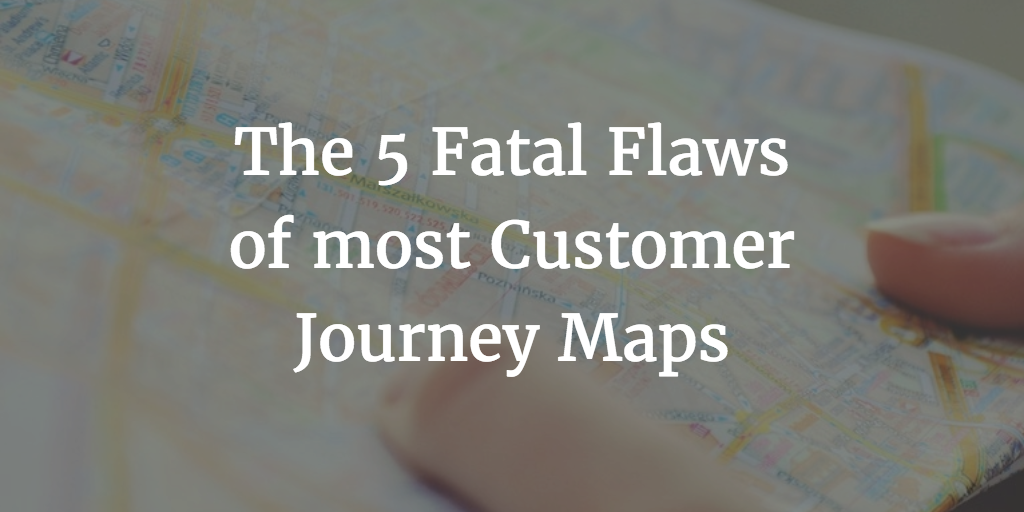
Very often, they are elaborate, colorful maps – some look like movie storyboards or even children’s board games – that take the customer on a journey to nowhere.
What journey are you mapping? If it’s not the one that takes your customer to their Required Outcome in an Appropriate Way (together, those two things make up the customer’s Desired Outcome), then it’s a map to nowhere for the customer… and to churn for you.
Honestly, from a true Customer Success Management standpoint, we shouldn’t even be talking about maps at all. Instead, we should be talking about something more like a navigation app like Waze that doesn’t just show how to get from static point A to point B, but changes the journey (and ETA!) based on the realities on the ground (current location, traffic, obstacles, the driver simply ignoring directions, etc.).
But for now, we’ll talk “maps”… and here are five fatal flaws of Customer Journey maps; some will only have one of these, others will have all 5. Enjoy.
1. Focused on the Vendor’s Goals for the Customer
Customer Journey maps are usually designed to get the customer to do what the vendor wants from a functional standpoint, instead of what is appropriate for the customer.
This is especially true in high-tech industries where the vendor has invested heavily in building out features customers may not even need or want.
Because of this inward focus on the functional use of the product, most Customer Journey maps do not include things the customer must do outside of the product.
2. Assumes Customers are Static
The design of Customer Journey maps assumes customers are static, when the reality is, customers evolve, grow, and change.
One reason for churn is that the customer evolves and grows but the vendor fails to recognize this.
On the other hand, a huge reason for exponential growth is that the customer evolves and grows and the vendor fully recognizes, understands, and operationalizes around this! That’s Customer Success-driven Growth.
Customers evolve and change over time and vendors need to recognize that their relationship with the customer – and the journey that customer must take to achieve their Desired Outcome – must evolve, too.
3. Details only Early Lifecycle Stages
Customer Journey maps focus only on early lifecycle “stages” like Onboarding and Implementation (which are often easier to understand or visualize) but fail to take into detailed consideration the 3, 5, 7, or 10 years a customer might be with the vendor.
The more you recognize this part of the customer lifecycle – the majority of it – the more likely you are to get a customer that will stay 3, 5, 7, or 10 years.
Fail to do this and you won’t need to worry about those subsequent years.
4. Expects Customers to Achieve Success at the same Pace
Most Customer Journey maps incorrectly assume all customers move along at the same pace – achieving success on a common cadence – rather than being built around Success Milestones or Data-driven Triggers (internal within the customer company or external from the market).
Onboarding is not complete simply because 30-days have elapsed.
Onboarding is complete when the customer is “onboard” … which needs to be a defined milestone. What does “onboarded” mean in the unique relationship you have with your customers?
5. Assumes All Customers are the Same
Customer Journey maps generally treat all customers the same instead of being designed specifically around the Appropriate Experience for each logical customer segment.
This comes from an inward focus on the functional use of the product rather than a focus on the customer’s success.
Design a Customer Success-driven Experience
Your Customer Journey map will be awesome if you understand what the Desired Outcome of the customer actually is and map their journey toward that ever-evolving success. Which means, to even start creating a Customer Journey map… you must know what the customer’s Desired Outcome is.
Otherwise, you’re creating a map to an unknown – or incorrect – destination.
So before you draw an elaborate map to nowhere, start with an ugly line-listing of the steps required to get the customer from where they are when they sign-up for your product or service to where they need to be. It’s not about the map… it truly is about their journey.
Remember, your entire Customer Experience will be awesome if you design that experience to actually deliver success. Otherwise, what experience are you designing?